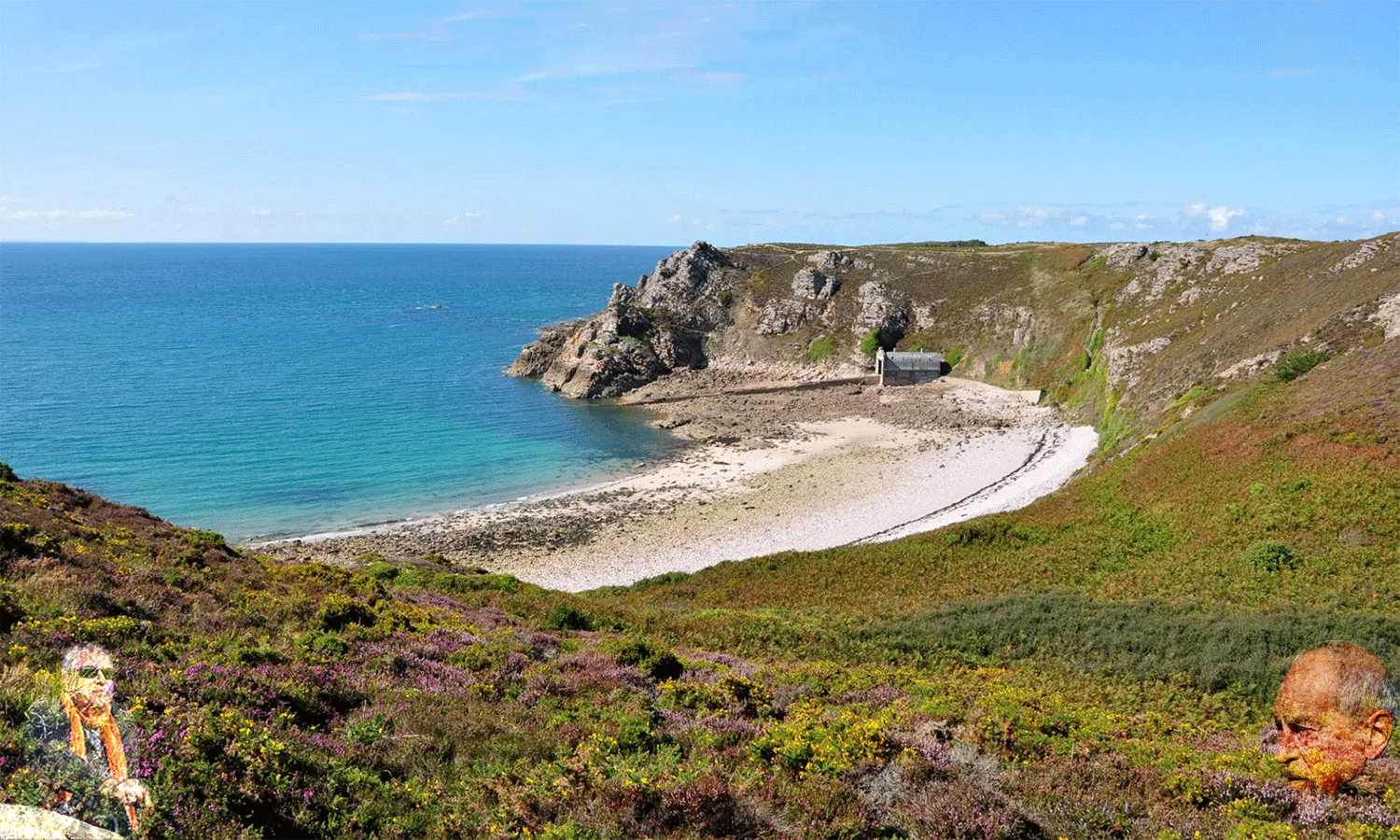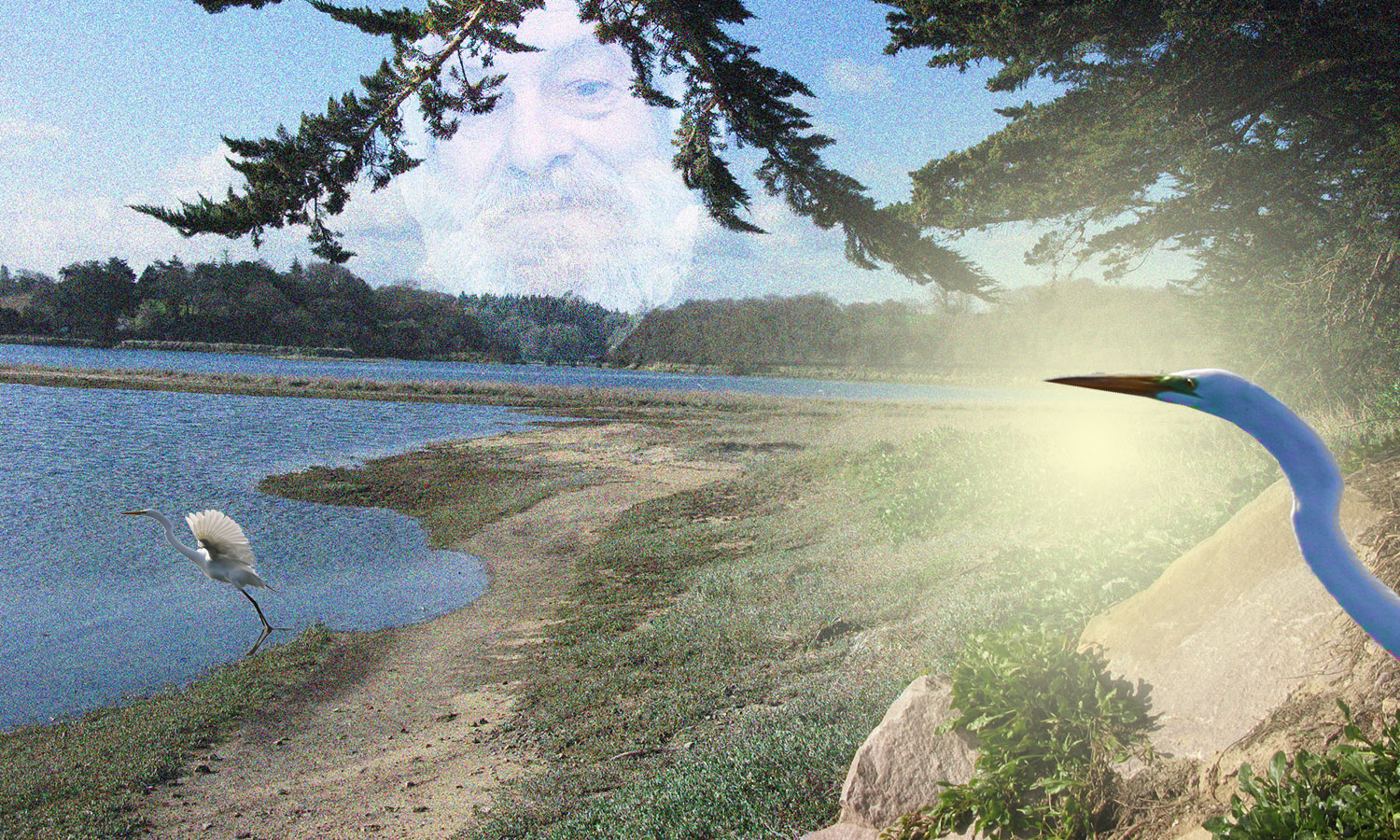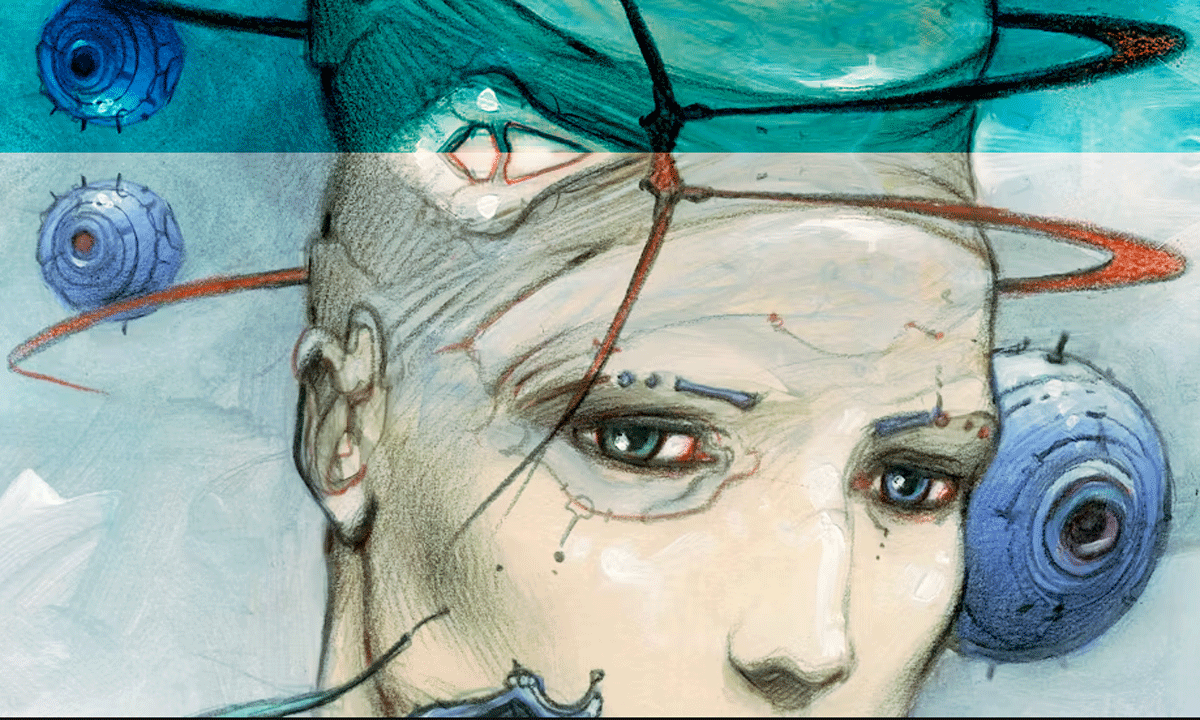
My house is perched – I am too, necessarily. Both perched on the cape of Erquy, overlooking the sea, the port, the sculptural rock point and some of the ten beautiful beaches of my eternal town. Yes, eternal. No chauvinism in that, as you will see.
Etymology
Yes, eternal. No chauvinism in there, what do you mean?
Eternal, Erquy is in more ways than one. This pretty fishing and yachting harbour has its origins in a small Gallo-Roman counter, Reghinea or Rekinea, according to the official version of local history. Moment please! Rekinea? The name is not Roman, but Greek. In Latin we would have said Rekinova, The new reki. We dropped the news, and Reki became Erquy. Which should be written Erki or Arki.
Which would be more Breton, by the way. Or more Arab? Arki reminds me of the Harkis, those Algerians who fought alongside Colonial France against their independentist compatriots.
Ar, Breton definite article. Ki is Ki or Chi, the subtle energy of the Chinese. Arki, land of subtle energy, I have known it since childhood. I lived it deep inside. When my parents moved here, I was 4. With Papa, I planted a pine tree – today venerable. A half-buried dolmen, the Devil Stone which gives its name to my street, makes the whole hill vibrate, echoing the powerful emissions of Guihalon.
My life is in Erquy. My liquid roots. My fine sand flowing between my fingers like a silk scarf. My land forever, my wild almost-island, my heather moors, my pink cliffs. This is why I chose to baptize my bio-energy with a famous name, reiki, which I spell reki, yes, the reki of Erquy. The name is certainly famous, but the technique is usurped. It has its origins right here, in Reki Nea, Reki Nevez, New Reki.
The etymology is not fanciful. It was inspired in me by a lover of Erquy, Hervé Kérivel. His father was keen on local history. A few decades ago, he unearthed this Greek etymology which tightens the link between the current name, Erquy, and the ancient name, Reki. Discovery which interested no one, neither then nor today, I suppose. No one is a prophet in his own country, they say.
I got hooked straight away. There is the language of the birds in there. I did some research. Here are the results.

Roman port
The presence of the Romans in Erquy is no secret. On the center beach, near the pointe de la Hussaye, you can see the trace of a small pool. This is all that remains of the ancient Roman port. In Gallo-Roman Brittany, the port of Erquy was the resort of the rich bourgeois of Condate, now Rennes. A Roman road connected the two towns via Corseul, the ancient Coriosolis where the remains of a temple of Mars are found. Condate-Coriosolis-Rekinea, such was the service of this via Romana.
My garden clings to the slopes of Cap d’Erquy, where archaeologists discovered the remains of a Roman camp in the last century. Is it Laudanum, Bibendum, Babaorum or Petibonum?Names of Roman camp in Asterix adventures I don’t know, but it’s here. The Gauls who resist the Roman invader, a well-known story … Joking aside, did you know that Erquy is the model of the Gallic village of Asterix?
The cover page of the Asterix albums shows a glass onion magnifying a detail of the Côtes d’Armor. This detail represents the village of Asterix. It’s right at Erquy’s location. Uderzo has endowed this village with a cape extended by three reefs. At the end of Cap d’Erquy line up Les Trois Pierres,the Three Stones well known to local sailors.
Youth of Uderzo
Before becoming a successful cartoonist, the young Albert Uderzo lived the war here in Erquy. When his friend René Goscinny suggested that he draw the adventures of the teigneux little Gaul, Uderzo naturally chose to locate him here, in Erquy. In my village. Today the invader is no longer Roman… But the Celts are still resisting!
Spicy detail, when Uderzo drew his Gallic village surrounded by the four Roman camps of Laudanum, Babaorum, Petibonum and Devinette: what is the name of the last one? , he was unaware that Cap d’Erquy once housed a Roman camp. Surprising, isn’t it? I love synchronicities, coincidences that are not. On this point, Erquy has always served me the lion’s share. I let Osiris guide me, he filled me so often! Also, I praise him at all times under his real name: Ousir al Hazar.
There is no such thing as chance. Everything that happens is wanted.

Seniority
As I said, the suffix nea is not Latin, but Greek. Which clearly shows that this ancient Reki was first a Hellenic trading post before becoming a Roman port in conquered Gaul. Oh yes, conquered, alas! The Gallic village did not resist the invader, and the little Gaul with a winged helmet was renamed Astericus…
Stronger still, Rekinea was a Greek counter before being a Roman one. Always stronger: before the Romans, before the Greeks, there were other settlers from the far reaches of the Mediterranean, from ancient Sumer. Yes, from Sumer, at the heroic times of the god Enki, creator of the first man, Adapa who was renamed Adama by the Greeks and Adam by the Bible. Enki decomposes like this; En, in. Ki, the earth.
Enki ruled over the depths of the planet, while his brother Enlil (En, in; Lil, The island) ruled over the Watchers’ Island, the Great Sun of the North, Kharsag, the Isle of the Giants, the Isle of Reptilians, Turtle Island, the magical island of Avalon, the Island of the Four Masters, Eden, the Paradise or to give it its Greek name that explains everything, Hyperborea. Hyper, beyond. Boreas, the north pole.
All the gods came from Hyperborea.
Erquy Reki
Before being the new Reki of the Greeks and Romans, there has been an ancient Reki founded by the Sumerian, as shown by its etymology.
Re or Ra, the Sun. Ki, the Earth, our planet.
Reki means the Sun Earth. Hyperborea. Or the Earth Sun. It is a name of great nobility and great antiquity. The Sons of the Sun, like Lugh the giant cyclops, passed by here in heroic times. So many secrets, forgotten philtres, magic potions and elixirs of long life have been designed, concocted and consumed in this bay, in my eyes the most beautiful in the Celtic world.
Reki is also the name of the art of healing the body and soul that I have been practicing for 35 years. Does it owe much to Japanese reiki? I don’t think so. I tend to think the opposite, Japanese reiki owes a huge debt to the Sumerian reki, the one I found strand by strand, gesture by gesture, in my magical city, on the sacred hill of Cap d’Erquy.

The Eighteen Chakras
Those of you who have experienced the reki of Erquy, who have received the effect it makes, who have watered with sea and great wind on the cliffs of Erquy, who have trod the sands of the dunes and the heather of the high roads, come back: you will not believe it. I was looking for this wonder reki, this treatment that awakens and makes the body alert. It works the chakras out of the body as well as the seven body chakras. It still awakens two chakras above the body, two others under the feet.
Reki is also Reiki, but I prefer the first spelling — the one of magical Erquy, the city where I anchored in 1953. I was four years old. Since I come there most often, between two long trips. The retreat came, I settled there to remain, still unaware why I was so attracted by this delicious seaside resort, fishing port, and city of a stunning antiquity: before being resort port for the Roman invaders, it was Greek counter, and even before the Hellenic invaders, it was already Celtic under the name of Reki.
Two years ago, I expanded my practice of Erquy reki. In my cleansing of the energetic scheme, the tree of life, the sephirots of the Hebrews. Not content with purging the seven known chakras, I included the other seven, our secondary chakras. For some time, I worked on fourteen chakras, feeling that the evolution of my practice would not stop there. I then discovered the seven degrees of awakening and the eighteen chakras. To help my visitors climb these levels, I was missing the touchstone. (read more)
The Erect Sphinx
Djian seems asleep. I stop. I am two metres behind his head. Standing I am too high. I kneel. My head is exactly at his height. He can’t see me: lying on his back, he can only see the beams of the frame. Not even: he keeps his eyes closed. I am totally released. My body tells me the exact position I must adopt. I obey him in every way.
Kneeling, body at a precise 90° angle with legs, back flat, arms extended to Djian at a precise 90° with trunk. The head perfectly vertical in the exact axis of the trunk. Rigor. Precision. The slightest deviation, I get an electrical discharge from the wrong place.
As long as the position is not perfect, rigid, hieratic, nothing happens but these punitive discharges. It works. I understand what my body has to do. I help. I’m there. As soon as I find the right attitude, an incredible surge of energy crosses my body and runs to the end of my arms, towards Djian who takes everything in the body.
Slight spasms run through it. It does not seem affected by the intensity that I feel bubbling in it. He absorbed everything without leaving a shred. Good, because if he rejects some, this energy comes back to me ten times stronger, and always negative. It is an automatic defense of the subtle body and aura. Anything too strong is rejected. Return to sender in negative form. But not with Djian. (read more)

Vestiges
Yet, to go back in time, one should not stop on such a good path. Erquy has much older remains. There is the dolmen of the Pierre au Diable, in my garden. Another ruined megalith, the dolmen of the Hamon City, can be admired in the street of the same name.
There are also the carved rocks of the wild beaches. The Urtoué, the Portuais, the Guen and Saint-Michel contain astonishing carved rocks, heads of giants or animals for the most part, which the curious walker will have fun to spot on the beaches in question. Continuing towards Cape Fréhel, we will see other remarkable rocks, jet-black, on the white sand of the beach of La Fosse. On this same beach, many eroded sculptures can be discerned on the pink sandstone cliffs.
The air is lively and light, the sea spray is charged with iodine, the sandpipers run like crazy at the edge of the water. Their compact band seems driven by a single pilot, as their movements are coordinated. I take a walk, I oxygenate myself, I recharge with energy queen. The wind from offshore brings the echo of the Celtic lands. He speaks of Ireland and Scotland, of Cornwall and Wales, lands dear to the heart of little Brittany, which watches the Great One recede, just across the Channel.
Deceased Meetings
Several of you have wished to meet me. They also need to meet Erquy, its capes, its cliffs, and its wild coast. They must meet my house and the guest house in the same garden, a venerable garden, on slopes and terraces facing the big blue that streams of sun.
I also love dating, they are the salt of life. That’s why I imagined the Rencontres d’Erquy. At the beginning I said Soul Encounters, so they were. But on reflection, the soul that drives me and lives in these meetings is here, dear friends, it’s Erquy. Come bathe in her frank and soft aura, her direct and captivating light… and leave if you can!
Rencontres has experienced what roses experience, the space of a garden. One can easily meet me on the internet, and agree on a visit. I heal, I listen and the bad goes. The body is a pure reflection of the soul. I pamper the soul to delight the body. Come.
If the desire takes you without understanding why, it’s even better. Real pains are silent, they say. The real encounters are obvious, in any case. Everything that happens surprises me. Chance does not exist, but destiny holds us in its hand. Come on.

Para-linguistics
- Erquy, the Ancient Rekinea
- Temporal Riddles
- Fairy Laughter
- Alcor, Ursa Major
- Borobudur
- Divine Names Of The Planets
- Secret Meaning Of Breton Diwan
- Bael Bec aka Baalbek
- The Language Of The Birds
- The Origin Of Languages
The Author
- Xavier By Himself
- My Forty Inhabitants
- Who Am I?
- Tree Houses
- My father
- Cinephile
- My Awakening Path
- Self Portrait
- In Memoriam Devic
- February 14th
- Friend Devic
- Ten Years After
- Farewell Dear Stef
- Public Confession
- My Parallel Lives
- Rebirth
- How Lucky I Am!
- High Solitude
- Learning Her


